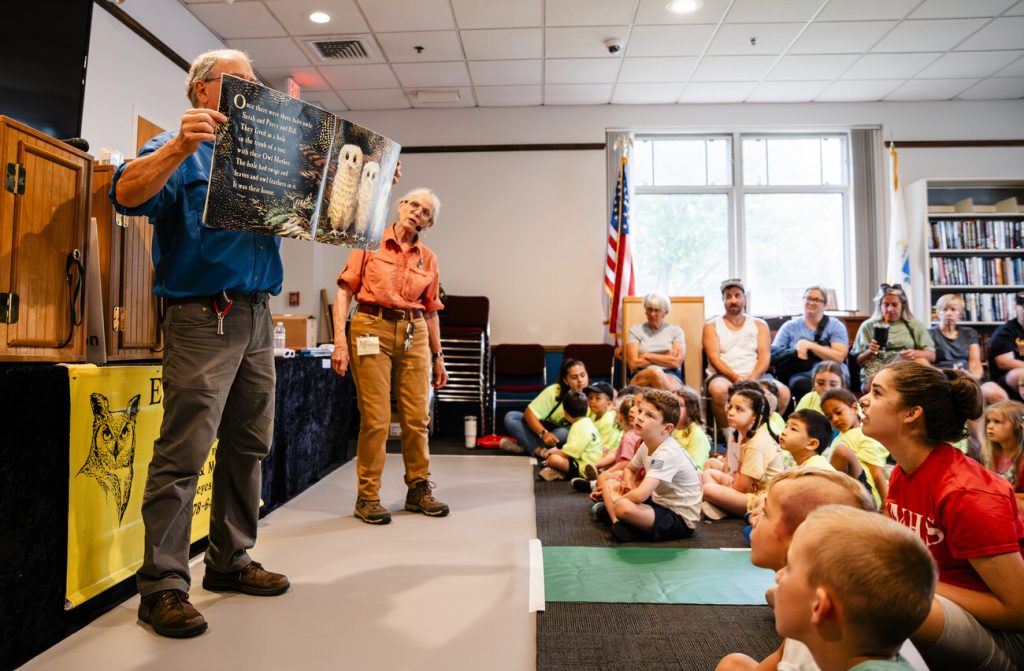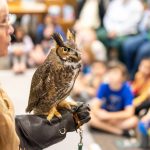SAUGUS — Thursday morning, locals filtered into the Community Room at the Saugus Public Library to get to know some feathered friends. Due to the rain, the event had to be moved from the Saugus Iron Works.
Marcia and Mark Wilson, who founded the program in 1994, gave the crowd lessons on hooting and showed off some of the owls they care for.
Marcia Wilson started the program off by showing the crowd her Great-horned Owl hooting skills. She then read the book “Owl Babies” to everyone before she began bringing out the owls.

She gloved up for safety before hooking two leads to her belt and opening the first two boxes. Inside each were Eastern Screech Owls, one brown and one red.
“They’re pretty common here in Massachusetts,” Mark Wilson said as Marcia Wilson took the owls out. “And these are not babies, even though they’re tiny. They’re full-grown and they’re actually 11 years old.”
He said these owls don’t actually screech but instead make two sounds, a whinny and a trill. The two showed the crowd how to make a whinny sound before playing a recording of the more difficult to impersonate trill sound. “So if you hear any of those noises outside of your neighborhood, that’s a screech owl making a whinny or a trill,” he said.

Mark Wilson explained the two owls came from a science study in Maryland, along with two other Eastern Screech Owls. He said there were 86 of them that needed a home, and they were able to adopt four of them.
Next to pop out was a Barred Owl, which was much larger than the quarter-of-a-pound screech owls. Marcia Wilson told the audience the Barred Owl they had tended to try to jump off her hand, and asked that the audience not scream. She then gave a hooting lesson for the owl’s sound.
Mark Wilson then told the story of the Barred Owl, which was out hunting in New Hampshire when it was hit by a car on the highway. He ended up with a broken wing, and now he can’t fly.


“In his outdoor cage we give him a handicapped ramp and he can climb up and down. … If he wants to (be) up high he goes up the ramp, and if he wants a drink of water he comes down the ramp. He lives with his girlfriend and she can’t fly either. She was hit by a car in New Hampshire, also,” he said.
Mark Wilson also said Barred Owls have become a lot more common in Massachusetts over the years, and they have been preying on Screech Owls.
Marcia Wilson then took out a Barn Owl, which doesn’t hoot, but hisses, screeches, and screams instead. “Barn Owls have a beautiful heart-shaped face, and look at all the spots. They’re covered with spots to help them be camouflaged,” she said.
The Barn Owl and her sister were born in captivity as teaching owls and live together at the Wilson’s location.
Mark Wilson then brought out a “mystery raptor,” which was an American Kestrel. They explained that only Mark Wilson handled her because she was starting to dive at Marcia Wilson. He said the bird viewed him as a mate, which is why she didn’t like Marcia Wilson.
“Here in Massachusetts, they’re in trouble. They’re not very common because bigger hawks can eat them,” he said. “Also, a lot of our fields have grown back into forest, and that’s where they hunt,”

Marcia Wilson next brought out a Great-horned Owl who she said was “very afraid of things,” and once again asked the audience not to scream if he began to flap. During the presentation, the Wilsons also emphasized the importance of not using rat poison, which can often time seriously harm owls as they can end up eating poisoned rats. They used their Great-horned Owl as an example.

“This owl had a rough life. He was out hunting one day and flew across the road. He didn’t look for traffic, and boom, he got hit by a car and broke his right wing. Now, he’s on foot, he’s still hungry, and he’s walking through people’s yards. He sees a rat or a mouse that’s looking kind of sluggish, and he grabs it with his foot, kills it with his talons, eats it, and the owl did not realize that rat or mouse had been poisoned,” Mark Wilson said.
The rat poison caused him to begin bleeding internally. Someone found him near death and brought him to the New England Wildlife Center. “He was in there for three months in the hospital, and they saved his life. Now he’s the poster child for the reasons why we shouldn’t use rat or mouse poisoning,” he said.
The last owl to make an appearance was the only one not found in the New England area, a Spectacled Owl, which is native to Central and South America.
The pair thanked everyone for coming before Marcia Wilson brought an Eastern Screech Owl out into the hallway to show to those who were unable to fit into the Community Room.

Photo: Spenser Hasak | Purchase this photo
A gray eastern screech owl looks happy to be at Saugus Public Library on Thursday as Eyes on Owls pays a visit.

Photo: Spenser Hasak | Purchase this photo
Marcia Wilson, of Eyes on Owls, shows off eastern screech owls to a group of kids at Saugus Public Libary.

Photo: Spenser Hasak | Purchase this photo
Marcia Wilson, of Eyes on Owls, shows off an eastern screech owl to a group of kids at Saugus Public Libary.

Photo: Spenser Hasak | Purchase this photo
Mark Wilson, of Eyes on Owls, teaches kids and their parents to avoid using poison when dealing with mice and rats because it is harmful to owls and other birds of prey during his visit to Saugus Public Library on Thursday.

Photo: Spenser Hasak | Purchase this photo
A gray eastern screech owl calls out as she visits Saugus Public Library on Thursday.

Photo: Spenser Hasak | Purchase this photo
Samuel LoPresti, of Saugus, cups his hands around his ears so he can hear like an owl as Eyes on Owls visits Saugus Public Library on Thursday.

Photo: Spenser Hasak | Purchase this photo
Marcia Wilson, of Eyes on Owls, introduces the crowd gathered at Saugus Public Library to a great horned owl.

Photo: Spenser Hasak | Purchase this photo
Siblings Rishi, left, and Briyana Maharjan, of Saugus, get to meet a barred owl as Eyes on Owls visits Saugus on Thursday.

Photo: Spenser Hasak | Purchase this photo
Marcia Wilson, of Eyes on Owls, shows off a barred owl to the crowd gathered at Saugus Public Library.

Photo: Spenser Hasak | Purchase this photo
An American kestrel flaps its wings as it visits Saugus Public Library.

Photo: Spenser Hasak | Purchase this photo
Marcia Wilson, of Eyes on Owls, introduces the crowd gathered at Saugus Public Library to a spectacled owl, which is native to Central and South America.



